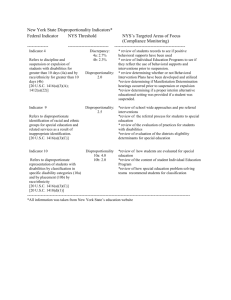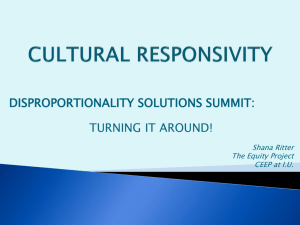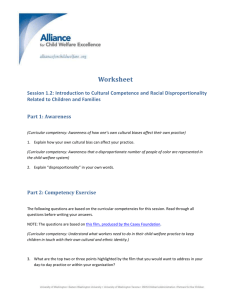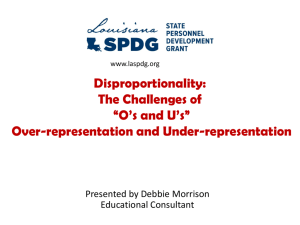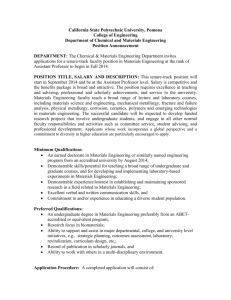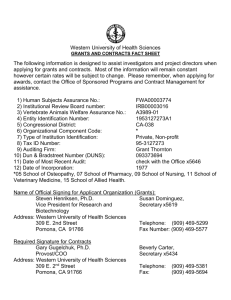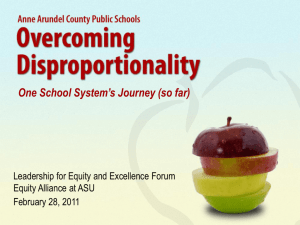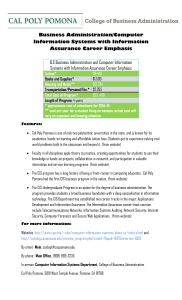Rev. x2 SIG DIS Key Message PLC Action Team pullout
advertisement
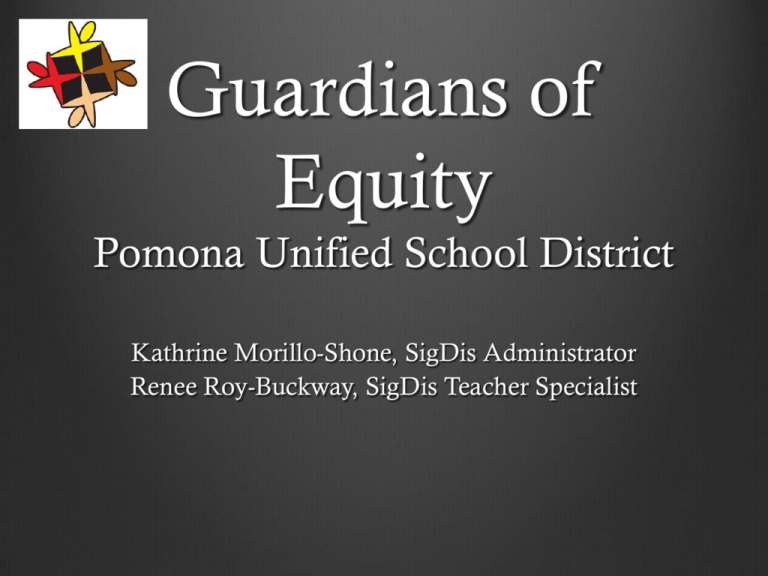
Guardians of Equity Pomona Unified School District Kathrine Morillo-Shone, SigDis Administrator Renee Roy-Buckway, SigDis Teacher Specialist Welcome and Warm-up School site administrator will introduce their team and say whether or not the school is one of the six pilot sites for the 2013-14 school year. Outcomes Understand the concept of disproportionality Connect the criteria for identifying students as Emotionally Disturbed to the causes of disproportionality. Identify the key components of the SD-CEIS Plan. Develop an awareness the consequences of failing to be guardians of equity. Anticipation Reaction Survey Please take a few minutes to independently fill out only the Anticipation column of the Anticipation Reaction Survey We will come back to it at the end of the session today so please keep it WHAT IS DISPROPORTIONALITY? What is Disproportionality? Disproportionality or disproportionate representation is the inappropriate overrepresentation or over-identification of a given population group, often defined by racial and ethnic backgrounds, but also defined by socioeconomic status, national origin, English proficiency, gender, and sexual orientation, in a specific population category. Percentage of Designated Populations in Special Education in Pomona USD? Pomona’s District Population Asian = 5.05%, African-American = 5.24% Hispanic = 84.57% White = 3.64% (1,451) Asian 14.68% of Asian Students (213) (1,505) African American Hispanic (22,757) (1,060) White 21.99% of 11.63% of 16.70% African Hispanic of White American Students Students Students (177) (2,647) (331) 6 CAUSES OF DISPROPORTIONALITY Making the Abstract Concrete Activity How might this factor contribute to disproportionality? Give examples. What does this factor look like when it is culturally responsive? Give examples. REASONS FOR PUSD’s SigDis STATUS In July 2012, the Pomona Unified School District was identified by the California Department of Education (CDE) as significantly disproportionate in its over identification of African Americans for Special Education and related services in the area of emotional disturbance for the academic year 2010-2011. In July 2013, the Pomona Unified School District was once again identified by the California Department of Education (CDE) as significantly disproportionate in its over identification of African Americans & White students for Special Education and related services in the area of emotional disturbance for the academic year 2011-2012. Begin with the End in Mind SHORT- TERM GOAL: Reduce by 5% the number of referrals to special education for African American & White student groups for each academic year. LONG- TERM GOAL: Permanently exit the Significantly Disproportionate status and fully transform into a Culturally Responsive and Equitable District ED Eligibility Ah-ha’s and Uh-oh’s How objective is the eligibility criteria? To what extent are the criteria open to interpretation? To what extent are the criteria vulnerable to cultural biases? Is it possible to misidentify or over-identify based on the individual or cumulative criteria? Is it possible that a temporary situation could cause any of these behaviors described, but the child is not truly Emotional Disturbed? PILOT SCHOOL SITES SPECIALIZED PLAN What does this all mean for Pomona USD? Gather additional data Build capacity at all levels Site Administrators Teachers Parents Students Intensive Professional Development on 4 focus areas: Culturally Responsive Teaching Response to Intervention and Instruction Positive Behavior Intervention Supports (including SST) Closing the Achievement Gap K-3 Direct Intervention Supports Intensive Progress Monitoring – CWT, Disproportionality Data Watch LONG-TERM HARMFUL EFFECTS -Once students are receiving special education services, they tend to remain in special education classes (Harry & Klingner, 2006). -Students are likely to encounter a limited, less rigorous curriculum (Harry & Klingner, 2006). -Lower expectations can lead to diminished academic and postsecondary opportunities (National Research Council, 2002; Harry & Klingner, 2006). -Students in special education programs can have less access to academically able peers (Donovan & Cross, 2002). -Disabled students are often stigmatized socially (National Research Council, 2002). -Disproportionality can contribute to significant racial separation (Harry & Klingner, 2006; Losen & Orfield, 2002). Center for Exceptional Children (2002) What are the Consequences? The achievement gap turns into the: Earning Gap Housing Gap Healthcare Gap _________ Gap (you fill in the blank) We are now faced with the fact that tomorrow is today. We are confronted with the fierce urgency of now. In this unfolding conundrum of life and history there is such a thing as being too late...We must move past indecisiveness to action. – Dr. Martin Luther King Jr. Thank you! Please leave your surveys. “The best case for public education has always been that it is a common good. Everyone ultimately has a stake in the caliber of schools, and education is everyone’s business.” —Fullan, 2003

